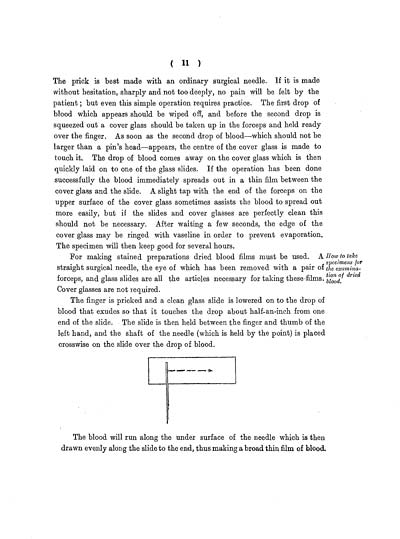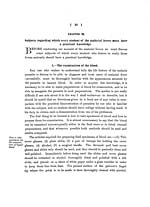Medicine - Disease > Malarial fevers
(17) Page 11
Download files
Individual page:
Thumbnail gallery: Grid view | List view

(11)
The prick is best made with an ordinary surgical needle. If it is made
without hesitation, sharply and not too deeply, no pain will be felt by the
patient; but even this simple operation requires practice. The first drop of
blood which appears should be wiped off, and before the second drop is
squeezed out a cover glass should be taken up in the forceps and held ready
over the finger. As soon as the second drop of blood-which should not be
larger than a pin's head-appears, the centre of the cover glass is made to
touch it. The drop of blood comes away on the cover glass which is then
quickly laid on to one of the glass slides. If the operation has been done
successfully the blood immediately spreads out in a thin film between the
cover glass and the slide. A slight tap with the end of the forceps on the
upper surface of the cover glass sometimes assists the blood to spread out
more easily, but if the slides and cover glasses are perfectly clean this
should not be necessary. After waiting a few seconds, the edge of the
cover glass may be ringed with vaseline in order to prevent evaporation.
The specimen will then keep good for several hours.
How to take
specimens for
the examina-
tion of dried
blood.
For making stained preparations dried blood films must be used. A
straight surgical needle, the eye of which has been removed with a pair of
forceps, and glass slides are all the articles necessary for taking these films.
Cover glasses are not required.
The finger is pricked and a clean glass slide is lowered on to the drop of
blood that exudes so that it touches the drop about half-an-inch from one
end of the slide. The slide is then held between the finger and thumb of the
left hand, and the shaft of the needle (which is held by the point) is placed
crosswise on the slide over the drop of blood.
The blood will run along the under surface of the needle which is then
drawn evenly along the slide to the end, thus making a broad thin film of blood.
The prick is best made with an ordinary surgical needle. If it is made
without hesitation, sharply and not too deeply, no pain will be felt by the
patient; but even this simple operation requires practice. The first drop of
blood which appears should be wiped off, and before the second drop is
squeezed out a cover glass should be taken up in the forceps and held ready
over the finger. As soon as the second drop of blood-which should not be
larger than a pin's head-appears, the centre of the cover glass is made to
touch it. The drop of blood comes away on the cover glass which is then
quickly laid on to one of the glass slides. If the operation has been done
successfully the blood immediately spreads out in a thin film between the
cover glass and the slide. A slight tap with the end of the forceps on the
upper surface of the cover glass sometimes assists the blood to spread out
more easily, but if the slides and cover glasses are perfectly clean this
should not be necessary. After waiting a few seconds, the edge of the
cover glass may be ringed with vaseline in order to prevent evaporation.
The specimen will then keep good for several hours.
How to take
specimens for
the examina-
tion of dried
blood.
For making stained preparations dried blood films must be used. A
straight surgical needle, the eye of which has been removed with a pair of
forceps, and glass slides are all the articles necessary for taking these films.
Cover glasses are not required.
The finger is pricked and a clean glass slide is lowered on to the drop of
blood that exudes so that it touches the drop about half-an-inch from one
end of the slide. The slide is then held between the finger and thumb of the
left hand, and the shaft of the needle (which is held by the point) is placed
crosswise on the slide over the drop of blood.
The blood will run along the under surface of the needle which is then
drawn evenly along the slide to the end, thus making a broad thin film of blood.
Set display mode to: Large image | Zoom image | Transcription
Images and transcriptions on this page, including medium image downloads, may be used under the Creative Commons Attribution 4.0 International Licence unless otherwise stated. ![]()
| India Papers > Medicine - Disease > Malarial fevers > (17) Page 11 |
|---|
| Permanent URL | https://digital.nls.uk/74558884 |
|---|




